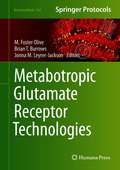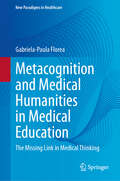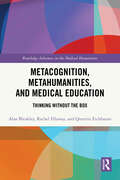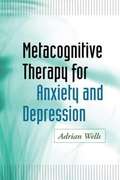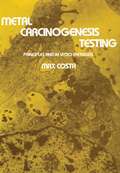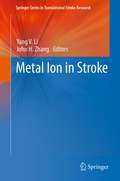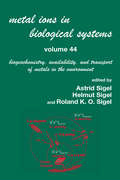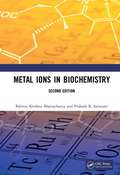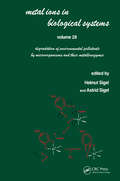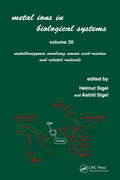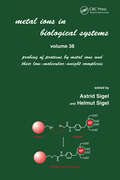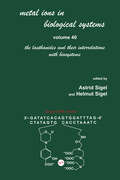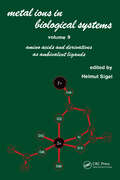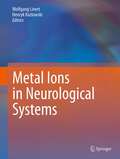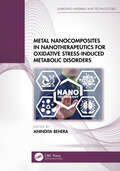- Table View
- List View
Metabotropic Glutamate Receptor Technologies (Neuromethods #164)
by M. Foster Olive Brian T. Burrows Jonna M. Leyrer-JacksonThis volume highlights various techniques used to study multiple aspects of mGlu receptor function. Chapters in this book cover topics such as modern approaches for the development and screening of allosteric modulators; fluctuations in intracellular calcium induced by mGlu receptor activation; dopamine-glutamate interactions in the central nervous system; methods for assessing mGlu receptor localization; and common techniques for evaluating mGlu modulation in behavior in rodents, including stress and alcohol drinking. In the Neuromethods series style, chapters include the kind of detail and key advice from the specialists needed to get successful results in your laboratory.Cutting-edge and practical, Metabotropic Glutamate Receptor Technologies provides researchers with a starting point to address important questions regarding mGlu and its importance. Researchers working in the fields of neuroscience and physiology of multiple peripheral systems will find this volume most useful.
Metacognition and Medical Humanities in Medical Education : The Missing Link in Medical Thinking (New Paradigms in Healthcare)
by Gabriela-Paula FloreaThis book offers a pioneering interdisciplinary exploration into the role of metacognition in medical education and practice, focusing on transforming the doctor-patient relationship through cognitive, metacognitive, and humanistic approaches. It provides critical insights into how metacognitive strategies can enhance communication, empathy, and decision-making in clinical settings, thereby improving patient outcomes, healthcare quality, and burnout syndrome prevention among healthcare practitioners. The main topics covered in the book include the analysis of traditional and contemporary models of medical practice, the cognitive dynamics between healthcare providers and patients, and the integration of metacognitive training in medical education and practice. The volume delves into the philosophical underpinnings of medical practice, comparing biomedical and biopsychosocial models while promoting a more nuanced, relationship-centered approach that considers individual belief systems and psychological needs. This book advocates for a shift in mentalities rather than a paradigm shift. These topics are not just important; they are crucial as they address the ongoing quality-of-care crisis in healthcare systems worldwide. By focusing on metacognition, the book highlights the importance of self-awareness, reflection, and critical thinking in medical practice. It challenges conventional paternalistic models by promoting a collaborative, humanistic approach that values the doctor-patient relationship as a dynamic, interdependent process.
Metacognition, Metahumanities, and Medical Education: Thinking Without the Box (ISSN)
by Alan Bleakley Quentin Eichbaum Rachel EllawayThis persuasive volume develops a novel approach to medical education and the medical humanities, making a case for the integration of the two to explore the ways in which ‘warm’ humanism and ‘cold’ technologies can come together to design humane posthumanist futures in medicine.There are many problems with conventional medical education. It can be overly technocratic, dehumanizing, and empathy-eroding, introducing artefacts that lead to harm and reproduce inequality and injustice. Use of the arts, humanities, and qualitative social sciences have been pursued as an antidote or balance to these problems. Arguing against the purely instrumentalist use of medical humanities in this way, this book addresses the importance of a genuine and open-ended engagement with humanities approaches in medicine. It discusses the impact of artificial intelligence and emerging theoretical frameworks and posthumanist perspectives, such as object-oriented ontology, on meaning making in medicine. It demonstrates how the key to such a transition is the recovery of the intrinsic art and humanity of metaphor-heavy biomedical science, in turn framed by models of dynamic complexity rather than static linearity.This book is an important contribution to debates around the medical humanities and its role in medical education. It is an essential read for scholars with an interest in these areas, as well as those working in science and technology studies and the sociology of health and illness.
Metacognitive Therapy for Anxiety and Depression
by Steven Hollon Adrian WellsThis groundbreaking book explains the "whats" and "how-tos" of metacognitive therapy (MCT), an innovative form of cognitive-behavioral therapy with a growing empirical evidence base. MCT developer Adrian Wells shows that much psychological distress results from how a person responds to negative thoughts and beliefs-for example, by ruminating or worrying-rather than the content of those thoughts. He presents practical techniques and specific protocols for addressing metacognitive processes to effectively treat generalized anxiety disorder, obsessive-compulsive disorder, posttraumatic stress disorder, and major depression. Special features include reproducible treatment plans and assessment and case formulation tools, plus a wealth of illustrative case material.
Metadata-driven Software Systems in Biomedicine
by Prakash M. NadkarniWhile the use of database technology is ubiquitous throughout IT (and health IT in particular), it is not generally appreciated that, as a database increases in scope, certain designs are far superior to others. In biomedical domains, new knowledge is being generated continually, and the databases that must support areas such as clinical care and research must also be able to evolve while requiring minimal or no logical / physical redesign. Appropriately designed metadata, and software designed to utilize it effectively, can provide significant insulation against change. Many of the larger EMR or clinical research database vendors have realized this, but their designs are proprietary and not described in the literature. Consequently, numerous misconceptions abound among individuals who have not had to work with large-scale biomedical systems, and graduates of a health or bioinformatics program may find that they need to unlearn what they were taught in database and software design classes in order to work productively with such systems. A working knowledge of such systems is also important for individuals who are not primarily software developers, such as health informaticians, medical information officers and data analysts. This book is, in a sense, intended to prepare all of the above individuals for the real world.
Metagenomic Systems Biology: Integrative Analysis of the Microbiome
by Shailza SinghThe book serves as an amalgamation of knowledge and principles used in the area of systems and synthetic biology, and targets inter-disciplinary research groups. The readers from diversified areas would be benefited by the valuable resources and information available in one book. Microbiome projects with efficient data handling can fuel progress in the area of microbial synthetic biology by providing a ready to use plug and play chassis. Advances in gene editing technology such as the use of tailor made synthetic transcription factors will further enhance the availability of synthetic devices to be applied in the fields of environment, agriculture and health. The different chapters of the book reviews a broad range of topics, including food microbiome in ecology, use of microbiome in personalized medicine, machine learning in biomedicine. The book also describes ways to harness and exploit the incredible amounts of genomic data. The book is not only limited to medicine but also caters to the needs of environmentalists, biochemical engineers etc. It will be of interest to advanced students and researchers in life sciences, computational biology, microbiology and other inter-disciplinary areas.
Metagenomics
by Rolf Daniel Wolfgang R. StreitMetagenomics has proven to be a powerful tool for exploring the ecology, metabolic profiling, and comparison of complex microbial communities as well as its important applications in the mining of metagenomes for genes encoding novel biocatalysts and drug molecules for bioindustries. In Metagenomics: Methods and Protocols, expert researches provide an overview and introduction to basic methods commonly used in laboratories that have a strong background in microbial metagenomics. The book attempts to address all of the working steps involved in this crucial field, beginning with DNA isolation from soils and marine samples and continuing with the construction and screening of libraries, along with key advise involving bioinformatic tools available to analyze large metagenomic sequence data sets. Written in the highly successful Methods in Molecular BiologyTM series format, chapters include brief introductions to their respective topics, lists of the necessary materials and reagents, step-by-step, readily reproducible laboratory protocols, and tips on troubleshooting and avoiding known pitfalls. Authoritative and cutting-edge, Metagenomics: Methods and Protocols serves as a very complete guide to available screening protocols for all major biocatalysts in order to allow for the easy setup of these screens in any microbiology lab.
Metagenomics: Techniques, Applications, Challenges and Opportunities
by Neeta Raj Sharma Reena Singh Chopra Chirag ChopraThis book summarizes the various areas of research in metagenomics and their potential applications in medicine, the environment and biotechnology. The book presents the recent advances in theoretical, methodological and applied aspects of metagenomics and highlights their applications in the fields of environmental microbial forensics, bioremediation, drug-discovery and agriculture. In addition, the book discusses various metagenomics approaches used for understanding the microbial physiology and biochemistry. Lastly the book describes a range of bioinformatics tools and computational methods for metagenomics analysis as well as the functional diversity and dynamics of microbial communities colonizing the human skin.
Metal Allergy: From Dermatitis To Implant And Device Failure
by Jacob P. Thyssen Jennifer K ChenThis volume opens by providing a comprehensive overview of the use and regulation of metals in our society, metal properties, and available testing methodologies. Common and uncommon metal allergens and sources of exposure are then reviewed in depth, detailing allergic responses and paying special consideration to select patient populations. In the general population, the prevalence of metal allergy is high. Environmental sources of metal exposure include jewelry, clothing, electronic devices, coins, leather, diet, and occupational exposure. Metal allergy may result in allergic contact dermatitis and systemic contact dermatitis, as well as several less common manifestations. Further, metal allergy has been associated with device failure and/or dermatitis following implantation of medical devices and dental implants. As metals are ubiquitous, this book will be indispensable for a wide range of clinicians and investigators. This handy reference will meet the needs of all health professionals and investigators who are interested in metal allergy and its diagnosis and management.
Metal Carcinogenesis Testing
by Max CostaThis text offers a comprehensive treatment of the fundamental biological, chemical and epidemiological principles of metal carcinogenesis and its assay as these are presently understood. It addresses problems of human exposure, the induction of tumors in experimental animals, and the effects of metal on "in vitro" systems. This book should be of interest to pharmacologists, toxicologists, epidemiologists, biologist, pathologist, industrial hygienists and those needing actively to assay metals and their compounds for carcinogenicity.
Metal Ion in Stroke
by John H. Zhang Yang V. LiStroke is a major cause of death and disability in the U.S. and worldwide. A variety of pathophysiologic episodes or cellular medications occur following a stroke, and knowledge of these aftermath events can lead to potential therapeutic strategies that may reverse or attenuate stroke injury. Cellular events that occur following stroke include the excessive releases of excitatory amino acids, alterations in the genomic responses, mitochondrial injury producing reactive oxygen and nitrogen species (ROS), and secondary injury, often in the setting of reperfusion.
Metal Ions In Biological Systems, Volume 44: Biogeochemistry, Availability, and Transport of Metals in the Environment
by Helmut Sigel Roland SigelVolume 44, devoted solely to the vital research areas concerning the biogeochemistry of metals and their transport in the environment and availability to living systems, offers 9 timely and authoritative chapters on these fascinating topics by 19 internationally recognized experts.
Metal Ions in Biochemistry: 2nd Edition
by Pabitra Krishna Bhattacharya Prakash B. SamnaniThe second edition of Metal Ions in Biochemistry deals with the multidisciplinary subject of bio-inorganic chemistry, encompassing the disciplines of inorganic chemistry, biochemistry and medicine. The book deals with the role of metal ions in biochemistry, emphasising that biochemistry is mainly the chemistry of metal-biochemical complexes. Hence, the book starts with the structures of biochemicals and the identification of their metal binding sites. Thermodynamic and kinetic properties of the complexes are explained from the point of view of the nature of metal-ligand bonds. Various catalytic and structural roles of metal ions in biochemicals are discussed in detail. Features The role of Na+ and K+ in brain chemistry. The role of zinc insulin in glucose metabolism and its enhancement by vanadium and chromium compounds. Discussion of the role of zinc signals, zinc fingers and cascade effect in biochemistry. Haemoglobin synthesis and the role of vitamin B12 in it. The role of lanthanides in biochemical systems. A detailed discussion of the role of non-metals in biochemistry, a topic missing in most of the books on bio-inorganic chemistry. The study of bio-inorganic chemistry makes biochemists rethink the mechanistic pathways of biochemical reactions mediated by metal ions. There is a realisation of the role of metal complexes and inorganic ions as therapeutics such as iron in leukaemia, thalassemia and sickle cell anaemia, iodine in hypothyroidism and zinc, vanadium and chromium in glucose metabolism. The most recent realisation is of the use of zinc in the prevention and treatment of COVID-19.
Metal Ions in Biological Systems, Volume 43 - Biogeochemical Cycles of Elements: Volume 29: Biological Properties Of Metal Alkyl Derivatives (Metal Ions In Biological Systems Ser. #29)
by Astrid Sigel; Helmut SigelMetal Ions in Biological Systems is devoted to increasing our understanding of the relationship between the chemistry of metals and life processes. The volumes reflect the interdisciplinary nature of bioinorganic chemistry and coordinate the efforts of researchers in the fields of biochemistry, inorganic chemistry, coordination chemis
Metal Ions in Biological Systems: Volume 21: Applications of Magnetic Resonance to Paramagnetic Species (Metal Ions in Biological Systems)
by Astrid Sigel Helmut SigelThis book facilitates a wider use of nuclear magnetic resonance in studies of paramagnetic species. It summarizes studies of magnetically coupled metalloproteins, of paramagnetic heme proteins, and of metal-porphyrin-induced dipolar shifts for conformational analysis.
Metal Ions in Biological Systems: Volume 28: Degradation of Environmental Pollutants by Microorganisms and Their Metalloenzymes (Metal Ions in Biological Systems)
by Astrid Sigel Helmut SigelContinuing to explore the relationship between the chemistry of metals and life processes, this volume in the Metal Ions in Biological Systems series examines the degradation of environmental pollutants by micro-organisms. It covers the action of micro-organisms and metalloenzymes on lignin, tannins, hemicelluloses, cellulose and aromatic compounds, as well as on halogenated aromatics and aliphatics; analyzes mechanistic aspects; considers the role of metalloproteases in biotechnology and wastewater sludge treatment; and describes the metal-dependent conversion of inorganic nitrogen and sulfur compounds.
Metal Ions in Biological Systems: Volume 30: Metalloenzymes Involving Amino Acid-residue and Related Radicals (Metal Ions in Biological Systems)
by Astrid Sigel Helmut SigelThis volume is devoted solely to the research area of metalloenzymes involving amino acid-residue and related radicals. Topics covered include: general considerations; structure, function and engineering of peroxidases; and ribonucleotide reductase in mammalian systems.
Metal Ions in Biological Systems: Volume 37: Manganese and Its Role in Biological Processes (Metal Ions in Biological Systems)
by Helmut Sigel"Highlights the availability of magnesium to organisms, its uptake and transport in microorganisms and plants as well as its role in health and disease of animals and humans including its toxicology."
Metal Ions in Biological Systems: Volume 38: Probing of Proteins by Metal Ions and Their Low-Molecular-Weight Complexes (Metal Ions in Biological Systems)
by Astrid Sigel Helmut SigelVolume 38: Probing of Proteins by Metal Ions and Their Low-Molecular-Weight Complexes focuses on the vibrant area of probing enzymes or proteins by metal ions and small complexes. It offers a summary of the basic characteristics of the amide bond, emphasizing its proton and metal ion interactions, including a quantitative analysis of its hydrolysis and formation. Topics include Peptide bonds, footprinting, protein degradation, protein complexes, and protein cross-linking.
Metal Ions in Biological Systems: Volume 40: The Lanthanides and Their Interrelations with Biosystems (Metal Ions in Biological Systems)
by Astrid Sigel Helmut SigelMany may know lanthanides under the homier name of rare earth elements, but that is less used scientifically because they are, in fact, not at all rare. Highlighting fast-moving research on lanthanides and their interrelations with biosystems, this book emphasizes the recent impact of these metals in biochemical, biological, and medical research, including in magnetic resonance imaging (MRI). The first two chapters outline their abundance and distribution, chemical properties such as oxidation states and ionic radii, and their mobilization through microorganisms like bacteria and fungi. It is written by 38 internationally recognized experts and enriched with nearly 200 illustrations and 1900 references.
Metal Ions in Biological Systems: Volume 41: Metal Ions and Their Complexes in Medication (Metal Ions in Biological Systems #Vol. 41)
by Patrick Graupp Robert J. WronaMetal ions are currently used for such applications as diabetes, anti-inflammatory, rheumatoid arthritis, psychiatric, and anti-ulcer medications, using compounds of vanadium, copper and zinc, gold, lithium, and bismuth, respectively. This text explores these applications in addition to an assessment of chelation therapy, uses in environmental scie
Metal Ions in Biological Systems: Volume 42: Metal Complexes in Tumor Diagnosis and as Anticancer Agents (Metal Ions In Biological Systems Ser. #28)
by Astrid Sigel Helmut SigelOffering an authoritative and timely account by twenty-nine internationally recognized experts, Metal Ions in Biological Systems: Metal Complexes in Tumor Diagnosis and as Anticancer Agents is devoted solely to the vital research area concerning metal complexes in cancer diagnosis and therapy. In fourteen stimulating chapters, the book focuses on d
Metal Ions in Biological Systems: Volume 9: Amino Acids and Derivatives as Ambivalent Ligands (Metal Ions in Biological Systems)
by Helmut SigelThis book focuses on the connection between the chemistry of metal ions and their role for life, and covers complexes with a number of amino acids with chelatable side chain donor atoms. It discusses metal ion-protein interactions and the ligating ambivalency of nucleotides.
Metal Ions in Neurological Systems
by Henryk Kozlowski Wolfgang LinertMetal ions in the brain are a necessity as well as a poison. The presence of metal ions in the active sites of biological catalysts or metalloproteins and in the biological functioning of nucleic acids is very well documented and they are required for brain activity. On the other hand, metals are very effective in generating oxidative stress. This effect does not only play a role in immunology but also is the root of practically all neurodegenerative disorders by inducing disease via the death of neurons. Managing metal ions in the brain could therefore be an important strategy in the search for therapeutic agents used in the treatment of neurodegenerative diseases. This new title gives an overview to key topics in the area of metal ions in the brain. It focuses on the role of metal ions in neurological systems by describing their advantageous functions as well as their poisonous features. It is therefore of interest for scientists in biochemistry and biophysics, physiology, toxicology as well as for physicians focused on this topic.
Metal Nanocomposites in Nanotherapeutics for Oxidative Stress-Induced Metabolic Disorders (Emerging Materials and Technologies)
by Anindita BeheraThis book highlights the role and mechanism of different metal nanocomposites toward oxidative stress-induced metabolic disorders including metabolic pathways affected by oxidative stress and related pathophysiology. The book includes an illustrative discussion about the methods of synthesis, characterization, and biomedical applications of metal nanocomposites. It focuses on the therapeutic approaches for metabolic disorders due to oxidative stress by nano delivery systems. Moreover, the book includes chapters on nanotherapeutic approaches toward different diseases, including diabetes mellitus, obesity, cardiovascular disorders, cancers, and neurodegenerative diseases such as Alzheimer's disease and Parkinson's disease. This book is aimed at researchers and graduate students in nanocomposites, nano delivery systems, and bioengineering. Features Discusses nanocomposites in the field of therapy for diabetes, obesity, cardiovascular disorders, neurodegenerative diseases, and cancers Details the pathophysiology of oxidative stress-induced metabolic disorder Explains mechanisms of the antioxidant potential of metal nanocomposites Discusses pathways to elucidate the therapeutic activity Reviews specific and precise applications of metal nanocomposites against lifestyle-induced disorders
